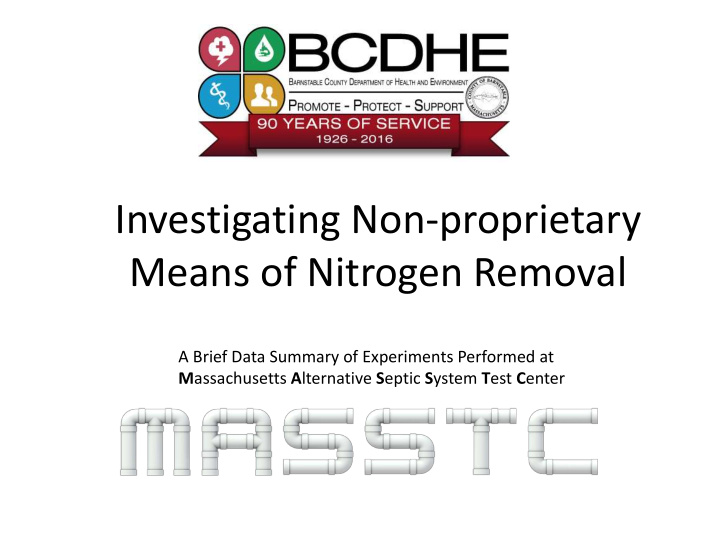



Investigating Non-proprietary Means of Nitrogen Removal A Brief Data Summary of Experiments Performed at M assachusetts A lternative S eptic S ystem T est C enter
• Damann L. Anderson, P.E., a researcher of passive nitrogen removal systems for the State of Florida Onsite Sewage Nitrogen Reduction Study (FOSNRS); • George Loomis, an onsite septic system specialist and published author from the University of Rhode Island; • Dr. Will Robertson of the University of Waterloo; • Jose Amador, a soil scientist at the University of Rhode Island; • John Eliasson with the Wastewater Management Section of Washington State Department of Health’s Division of Environmental Public Health • More recently, researchers at Stony Brook University, NY
To examine all elements of successful non-proprietary onsite denitrification projects and determine how to adjust the design features to work in our particular climatological and geological setting. To determine whether the principles used in these projects will allow a design that is economical and feasible to install in Barnstable County.
All projects investigated used ligno-cellulose (wood) or a byproduct as a carbon source to support denitrification
Initial investigations with soil columns suggested that sawdust could be incorporated into a soil profile following a layer for nitrification to achieve denitrification
1. Small scale unsaturated flow system hydraulically loading at code-prescribed rate; 2. Large-scale saturated system 3. Large scale “permeable reactive barrier” system (Silt-sawdust layer) 4. Large Scale unsaturated flow system 5. Additional soil column experiments
Cover 6- 8” Low pressure time dosed shallow drainfield Nitrify 18” System Profile < 48” Denitrify 18”
Small scale unsaturated flow system hydraulically loaded at code-prescribed rate 80 70 60 Total Nitrogen (mg/L) 50 40 30 20 Mean 5.6 mg/L TN Median 3.3 mg/L TN 10 0 Date LC TN LC Infl TN
Hydraulic Loading 0.6 gal/day/ sq. ft (220 gallons/day) Alternately dosed distribution laterals
BLC Total Nitrogen 80 Total Nitrogen (mg/L) 70 60 50 40 Mean 8.0 mg/L TN 30 Median 4.5 mg/L TN 20 10 0 Date BLC TN BLC Septic Tank TN BLC Inf TN
June 15, 2015 January 16, 2016
Sampling port Low pressure dosed distribution lateral Septic Tank Effluent - NH 3 → NO 3 Loamy Sand - → N 2(gas) Silty Sand/ Sawdust 20% NO 3
Sawdust sand-silt mix Place denitrification layer material (sawdust-sand-silt mix)
“Marry” denitrification layer material to nitrification material layer
Nitrification layer Excavate to base Denitrification layer
Field area levelled and made ready for distribution piping Low-pressure distribution piping placed
Final grade over soil treatment area Grass planted over soil treatment area
Grass planted over soil treatment area
Silt and Influent TN 70 60 Total Nitrogen (mg/L) 50 40 30 Mean 4.9 mg/L TN Median 4.1 mg/L TN 20 10 0 Date Silt Sump TN Influent TN Silt Port 1 TN Silt Port 2 TN
Cover 6- 8” Low pressure time dosed shallow drainfield Nitrify 18” System Profile < 48” Denitrify 18”
Loamy-sand nitrification layer Loamy-sand sawdust mix denitrification layer Sand base
GeoMat low-pressure dosed field
Leveled soil treatment unit prior to placement of low-pressure piping
Cover 6- 8” Low pressure time dosed shallow drainfield Nitrify 18” System Profile < 48” Denitrify 18” Hill Denite Total Nitrogen 60 Total Nitrogen (mg/L) 50 40 30 20 10 0 Date Hill TN Port 2 TN Port 3 TN Influent TN
Cover 6- 8” Low pressure time dosed shallow drainfield Nitrify 18” System Profile < 48” Denitrify 18” Hill Denite Total Nitrogen Started December, 2015 60 Total Nitrogen (mg/L) 50 40 30 20 10 0 Date Hill TN Port 2 TN Port 3 TN Influent TN
Main difference between layering and standard septic systems Septic tank effluent dispersal Nitrification Denitrification Final dispersal
Standard leaching trench Septic Tank - NO 3 - NO 3 - - NO 3 - NO 3 NO 3 - - - NO 3 NO 3 NO 3 - NO 3 - NO 3 - Groundwater Flow NO 3 - - NO 3 NO 3
Sawdust/Silt mix Shallow low pressure dosed drainfield Pump - - NO 3 - Septic Tank NO 3 - NO 3 - NO 3 NO 3 Chamber N 2(gas) N 2(gas) N 2(gas) N 2(gas) Groundwater Flow
• It appears that introducing ligno-cellulose into the soil profile can achieve reductions in total nitrogen from percolating wastewater • Further study needs to be performed to determine the optimal design (saturated vs. unsaturated) that considers costs. • Pilot systems at different-use households need to be installed and monitored to validate results found at the Test Center.
• Further beta testing with modifications of design that focus on how simple we can make it and still be effective. • Work with soil scientists to bracket the soil characteristics necessary • Put together the design manual for system installation. • Identify and address the regulators’ concerns • Install 12 systems in homes • Six seasonal • Three in outwash • Three in moraine • Monitor two years • Create design manual EPA Proposal • Save the world
Questions? Lawn atop saturated system January 1, 2016
Recommend
More recommend